Water-bound wonders and divine mysteries: uncover the biblical significance of marine spirits and their impact on spiritual journeys.

Marine Spirit in the Bible
You've likely heard theories about marine spirits in the Bible, but have you ever taken a closer look to see what Scripture actually says?
The Bible is rich with stories and symbolism tied to water, from the parting of the Red Sea to Jesus walking on water. These events aren't just historical accounts; they carry deep spiritual significance.
As you explore these biblical waters, you'll find yourself on a journey through tales of faith, fear, and divine intervention.
Let's embark on this exploration together, and perhaps you'll discover something about these narratives that resonates with your own spiritual journey.
Key Takeaways
- Water in the Bible symbolizes both life and spiritual purification, as well as chaos and destruction.
- Jonah's experience inside the great fish represents transformation, divine intervention, and the importance of submission to God's will.
- Marine metaphors, including storms and oceans, illustrate life's trials and God's overwhelming authority over creation.
- Biblical narratives use marine spirits and events to teach lessons on faith, obedience, and the power of divine miracles.
Biblical Waters: Symbolism and Significance

In the Bible, water serves as a multifaceted symbol, representing concepts ranging from life and purification to chaos and destruction. This duality is evident through various narratives and teachings, where water baptism emerges as a crucial ceremonial act. It signifies the purification of one's sins, embodying both a death to the old self and a rebirth in spiritual purity. This sacrament not only highlights water's cleansing properties but also its role as a pivotal element in Christian rites of passage.
Moreover, oceanic metaphors permeate biblical text, illustrating the immense power and unpredictability of the sea. These metaphors often symbolize life's trials and the chaos that precedes creation. The vast, untamed nature of the ocean serves as a reminder of the divine power that controls it, asserting God's authority over even the most chaotic forces. Through these metaphors, the Bible conveys the message that amidst life's tumultuous waves, faith provides an anchor, offering hope and salvation.
Analyzing these elements, it becomes clear that water's symbolic presence in the Bible is both profound and complex, embodying themes of transformation, challenge, and divine sovereignty.
The Story of Jonah: A Deep Dive
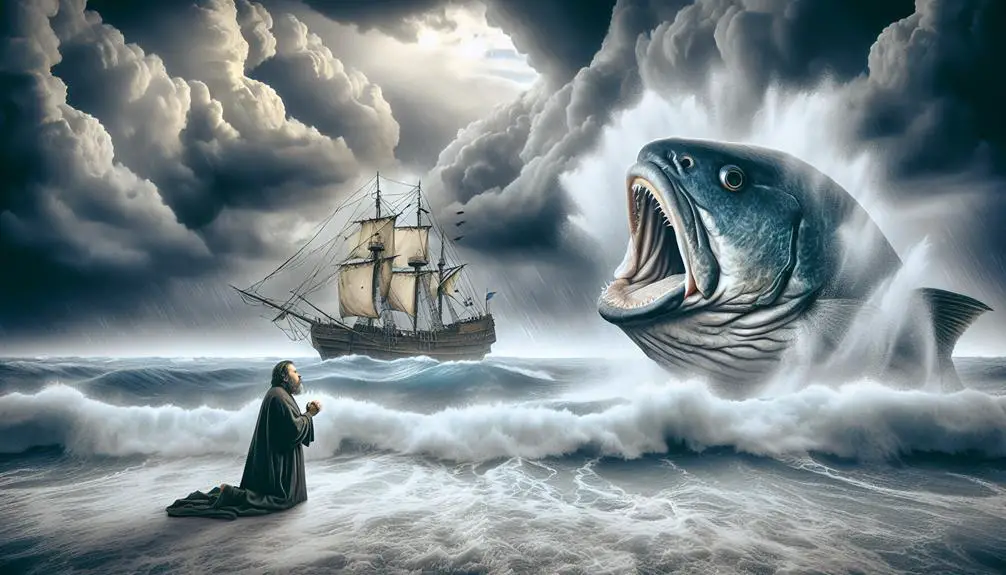
You'll find that the story of Jonah transcends a mere account of disobedience and redemption.
It intricately showcases Jonah's reluctant mission to Nineveh, his extraordinary experience inside the great fish, and ultimately, Nineveh's extensive journey towards repentance.
These elements collectively provide profound insights into themes of divine mercy, human rebellion, and the possibility of transformation.
Jonah's Reluctant Mission
Jonah's story exemplifies a profound reluctance to undertake a divine mission, revealing deep insights into human resistance to perceived destinies. This narrative unfolds a tale of nautical disobedience, where the prophet's plight becomes a symbol of defiance against divine will.
Jonah's decision to flee by sea, rather than prophesy against Nineveh, underscores a broader theme of evading responsibility. His journey embodies the conflict between personal desires and spiritual obligations, highlighting the inherent human struggle with submission to higher calls.
The sea voyage, chosen as a means of escape, ironically leads Jonah closer to the confrontation with his own fears and the ultimate realization of his prophetic role. This paradox illustrates the complex interplay between free will and divine intervention in fulfilling one's destiny.
Inside the Great Fish
Escaping divine command by sea, Jonah finds himself in the belly of a great fish, a pivotal moment that marks a deeper exploration into his spiritual journey and reluctance. This incident isn't just a tale of survival but delves into profound fish symbolism and the digestive miracle that kept Jonah alive.
- Fish Symbolism: Represents transformation and the unknown depths of the human psyche.
- Digestive Miracle: Illustrates divine intervention and the possibility of rebirth.
- Spiritual Journey: Jonah's internal conflict and eventual submission to divine will.
- Reluctance Overcome: Highlights the struggle between personal desire and divine command.
This narrative phase in Jonah's story underscores the intertwining of natural phenomena with spiritual lessons, demonstrating the depth of biblical allegories and their relevance to human experiences of faith, resistance, and transformation.
Nineveh's Repentance Journey
Upon reaching Nineveh, Jonah's proclamation of impending divine wrath catalyzed an unprecedented city-wide penitence, illustrating the transformative power of faith and repentance. The Assyrian Empire, known for its might and ruthlessness, witnessed an unparalleled Repentance Impact, fundamentally altering its societal and spiritual trajectory.
Aspect |
Significance |
|---|---|
Immediate Response |
Nineveh's collective fast and wear of sackcloth demonstrate a profound, communal acknowledgment of wrongdoing. |
King's Decree |
The Assyrian ruler's participation underscores the repentance's authenticity and depth, extending from the highest echelons to the common populace. |
Divine Mercy |
This event highlights the conditional nature of divine judgment, contingent upon genuine repentance. |
Historical Context |
Nineveh's response offers insight into the Assyrian Empire's capacity for spiritual and moral reform, challenging prevailing perceptions of its unyielding dominance. |
This narrative underscores repentance's pivotal role in redirecting destiny, both individually and collectively.
Jesus Calms the Sea: A Miraculous Encounter
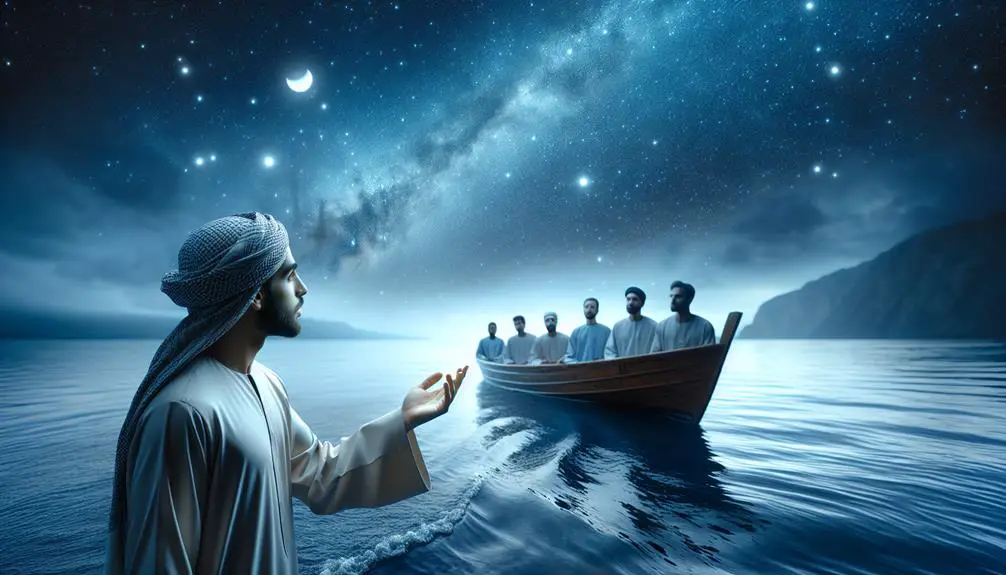
In the Gospel narratives, Jesus' miraculous calming of the sea stands as a profound demonstration of his divine authority over nature. As you delve deeper into this event, you'll notice it's not only about the power to quell physical storms but also serves as a metaphor for calming the storms within one's soul, embodying storm psychology. The disciples' fear and Jesus' response highlight a critical teaching moment about faith and divine providence.
The event carries rich Apostolic symbolism, underscoring Jesus' role as the protector and guide of the early Church through tumultuous times. The sea, often representing chaos and danger in ancient literature, becomes the stage for a powerful lesson in trust and belief.
To grasp the depth of this narrative, consider the following points:
- The storm symbolizes life's unpredicted challenges.
- Jesus' calm demeanor contrasts with the disciples' panic, illustrating different responses to crises.
- The calming of the sea emphasizes Jesus' authority over both natural and supernatural realms.
- This miracle teaches the importance of faith in overcoming fears and obstacles.
Analyzing this encounter, you're invited to reflect on the broader implications of Jesus' miracles, beyond their immediate context, enriching your understanding of biblical themes related to faith, leadership, and divine intervention.
Moses Parts the Red Sea: Divine Intervention
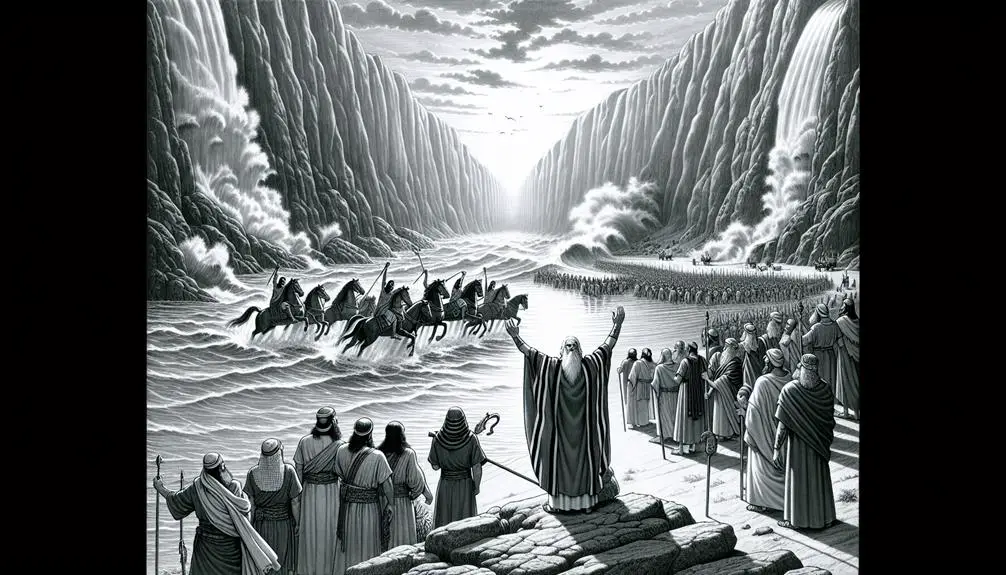
As we delve into the narrative of Moses parting the Red Sea, it's evident that this act of divine intervention not only showcases a pivotal moment in the history of the Israelites but also symbolizes the profound themes of liberation and faith. This event, marked by oceanic obedience, is a testament to the power wielded by divine forces over natural elements, guiding the chosen people to freedom. The parting of the Red Sea stands as a stark contrast to Pharaoh's defiance, highlighting a battle not just between two leaders but between omnipotence and human arrogance.
The Red Sea's submission to Moses' staff, upon God's command, is emblematic of the ultimate sovereignty of divine will over nature. This oceanic obedience serves as a clear message of the supremacy of faith over fear, and divine purpose over human resistance. Meanwhile, Pharaoh's defiance, culminating in the catastrophic drowning of his army, underscores the futility of opposing divine will. This narrative offers a profound lesson on the consequences of arrogance and the power of faith to lead one towards liberation, making it a cornerstone of theological discourse on divine intervention and human agency.
Peter Walks on Water: Faith and Fear
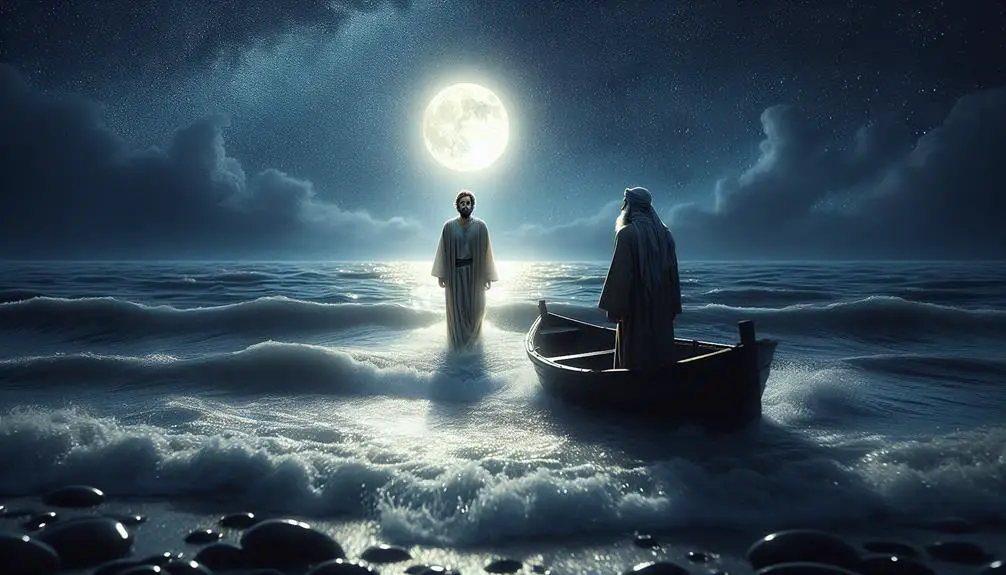
You must now examine how Peter's act of walking on water symbolizes the intricate interplay between faith and fear.
This analysis begins by defining the role of faith in confronting the inherent fear associated with the water's unpredictable nature.
Further, it explores Peter's transformation journey, highlighting the pivotal moments that signify his growth and the eventual mastery over his doubts.
Defining Faith's Role
Faith's pivotal role becomes evident when analyzing Peter's walk on water, a narrative that intertwines faith and fear. This moment in scripture is rich with oceanic metaphors, suggesting not just a physical crossing but a journey of spiritual hydration. Faith, in this context, acts as a conduit through which the divine can instill courage and transcendence over the natural elements.
To understand faith's role, consider these points:
- Faith bridges the tangible and the divine.
- It's a catalyst for spiritual growth.
- Faith transforms fear into fortitude.
- It's essential for navigating life's tumultuous waters.
In essence, faith doesn't negate fear but empowers one to face and overcome it, offering a spiritual buoyancy amidst life's vast and unpredictable seas.
Overcoming Water's Fear
Navigating the narrative of Peter walking on water reveals a profound exploration of overcoming fear through faith. This story not only highlights the importance of trust in divine power but also suggests practical steps for individuals grappling with aquaphobia or fear of water today. By engaging in swimming lessons or aquatic therapy, one can gradually build confidence in water, mirroring Peter's faith journey.
Strategy |
Application |
Outcome |
|---|---|---|
Faith |
Trust in Divinity |
Overcoming Fear |
Aquatic Therapy |
Gradual Exposure |
Confidence Building |
Swimming Lessons |
Skill Acquisition |
Mastery Over Fear |
Trust in Process |
Consistent Effort |
Sustainable Growth |
These methods provide a structured approach to conquering water-related fears, emphasizing the interplay between faith, trust, and practical action.
Peter's Transformation Journey
Peter's journey across the water, wherein he momentarily defies the natural order under Jesus's gaze, epitomizes the complex interplay between faith and fear in spiritual transformation. This narrative, deeply embedded within the matrix of fishing miracles and disciple dynamics, illustrates the precarious balance between divine empowerment and human frailty.
- Fishing miracles serve as a backdrop, highlighting the disciples' everyday reality and their transcendence into realms of faith.
- Disciple dynamics reveal the fluctuating levels of understanding and belief among Jesus's followers.
- Peter's attempt to walk on water underlines the instantaneous nature of faith, which can waver under the weight of fear.
- The rescue by Jesus underscores the continual need for divine intervention in the journey of faith.
Analyzing Peter's transformation offers insights into the spiritual journey's inherent challenges and the omnipresent tension between fear and faith.
The Great Flood: Judgment and Salvation
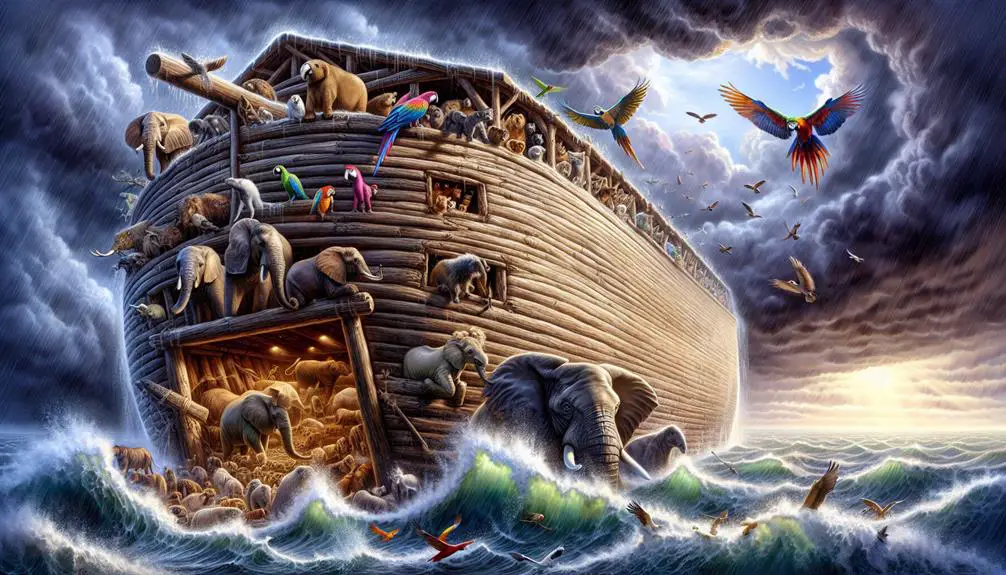
The Great Flood, as described in the Bible, represents a divine act of judgment and salvation, reshaping humanity's relationship with the divine. Central to this narrative is Noah's righteousness, standing in stark contrast to the widespread corruption of his time. Noah's adherence to divine principles earmarks him as uniquely worthy of preservation amidst the impending cataclysm. This distinction sets the stage for the construction of the Ark, a monumental task divinely ordained to safeguard Noah, his family, and representatives of terrestrial life from the coming deluge.
The Ark's construction, underpinned by explicit instructions from God, underscores the theme of divine salvation through obedience and faith. This initiative not only signifies a physical means of preservation but also symbolizes a covenant between God and humanity, represented by Noah and his lineage. The Flood narrative, while highlighting the severity of divine judgment against moral decay, equally emphasizes the possibility of redemption. Through Noah's example, the narrative conveys that righteousness and adherence to divine will can steer humanity towards salvation, even in the face of overwhelming judgment. This duality of judgment and salvation forms a foundational concept in the Biblical exploration of humanity's interaction with the divine, particularly in relation to marine phenomena.
Leviathan: The Sea Monster Described

In biblical texts, Leviathan emerges as a formidable sea monster, symbolizing chaos and opposing divine order. You'll find Leviathan's origin steeped in ancient mythologies, with the creature often representing the untamable and chaotic forces of nature. Scholars point out that Leviathan's depiction in the Bible isn't merely a creature of fantasy but a symbol of the immense power that only divine entities can tame or defeat.
When analyzing Leviathan, you encounter several key aspects that underscore its significance:
- Leviathan's depiction as a sea monster emphasizes the ancient fear and respect for the sea's unpredictable and dangerous nature.
- Its role in biblical narratives serves as a metaphor for chaos, which stands in opposition to the order established by God.
- Mythological comparisons reveal similarities with sea monsters from other ancient cultures, suggesting a shared cultural understanding of the sea's symbolic power.
- Leviathan's eventual defeat by God symbolizes the triumph of divine order over chaos.
This analytical perspective allows you to appreciate the depth and complexity of Leviathan's character in biblical literature, highlighting its role beyond a mere mythical creature.
Rivers in Eden: Paradise and Life

Shifting focus from the chaotic seas embodied by Leviathan, rivers in Eden represent the antithesis, offering a glimpse into paradisiacal life and divine order. Eden's geography, marked by these rivers, underscores the Bible's portrayal of Paradise as a place of harmony, nourishment, and direct communion with the Creator. Unlike the unpredictable and often dangerous marine realms, the rivers flowing from Eden symbolize life-giving water, purity, and the sustenance of God's creation.
The symbolism of these rivers extends beyond mere physical sustenance; they're metaphors for spiritual nourishment and the flow of divine grace. The Bible's narrative situates Eden at the crux of humanity's origin story, with its rivers delineating a sacred geography that's both literal and symbolic. This dual nature speaks to the heart of Paradise symbolism: a realm where the spiritual and material coexist in perfect balance.
In analyzing Eden's rivers, you're delving into the foundational elements of biblical cosmology—where the natural world reflects divine intentions and human destiny is intimately tied to this paradisiacal landscape. The rivers of Eden, then, aren't just water bodies; they're conduits of life, emblematic of the divine provision and presence that characterize the Bible's depiction of the ideal state of existence.
Frequently Asked Questions
How Do Early Christian Texts Outside the Canonical Bible Address the Concept of Marine Spirits?
Early Christian texts, specifically Gnostic texts and Apocryphal narratives, delve into the concept of marine spirits with a nuanced perspective. They don't straightforwardly align with canonical teachings but offer a broader, often allegorical interpretation of spiritual entities associated with water.
These writings analyze marine spirits through stories and teachings that didn't make it into the established Bible, providing a deeper, sometimes mystical, understanding of their significance within early Christian thought.
In What Ways Have Marine Spirits Been Interpreted or Reimagined in Modern Christian Theology and Spiritual Warfare Teachings?
In recent years, there has been a significant evolution in the understanding of spiritual entities within modern Christian theology. This shift has been influenced by cultural interpretations and theological debates. One area where this evolution is particularly noticeable is in the perception of marine spirits.
These entities are often reimagined through the lens of spiritual warfare teachings, which has broadened the scope of spiritual engagement. Furthermore, these discussions have deepened the analytical exploration of such entities in contemporary religious thought.
Are There Specific Prayers or Rituals Within Christian Tradition Aimed at Combating or Protecting Against Marine Spirits?
Wondering how to shield yourself from negative energies linked to the ocean?
In Christian tradition, specific prayers and rituals, such as oceanic exorcisms and sea blessings, are indeed practiced. These spiritual tools serve as a protective barrier against unseen forces.
They're not just about combating; they also embody a profound respect and understanding of the natural world's spiritual dimensions.
Analyzing these practices offers insights into Christianity's rich spiritual tapestry.
How Do Marine Spirits in the Bible Correlate With Similar Entities or Spirits Found in Other World Religions and Mythologies?
You're exploring how entities similar to marine spirits connect across various traditions, focusing on cultural parallels and mythological interpretations.
These spirits often embody water's unpredictable nature, symbolizing chaos, creation, or wisdom in different cultures.
You'll find that while names and narratives vary, the underlying themes of transformation, danger, and guardianship over aquatic realms are strikingly consistent.
This comparative approach reveals the universality of water-related deities and spirits in human spirituality and mythology.
Can Marine Spirits Be Considered as Angels or Demons Within the Context of Christian Angelology and Demonology, and How Are They Classified?
You're exploring whether entities labeled as 'marine spirits' fit within the angelic hierarchy or have demonic origins, analyzing their classification in Christian angelology and demonology. This inquiry demands a deep dive into both scriptural references and theological interpretations to discern their nature.
Conclusion
In conclusion, haven't the stories of marine phenomena in the Bible always captivated us, blending the natural with the supernatural?
From the parting of the Red Sea to Jesus walking on water, these narratives not only highlight the power and authority of the divine over creation but also symbolize deeper spiritual truths about faith, judgment, and salvation.
Analyzing these stories provides a nuanced understanding of biblical symbolism, inviting believers and scholars alike to ponder the profound connections between humanity, divinity, and the natural world.


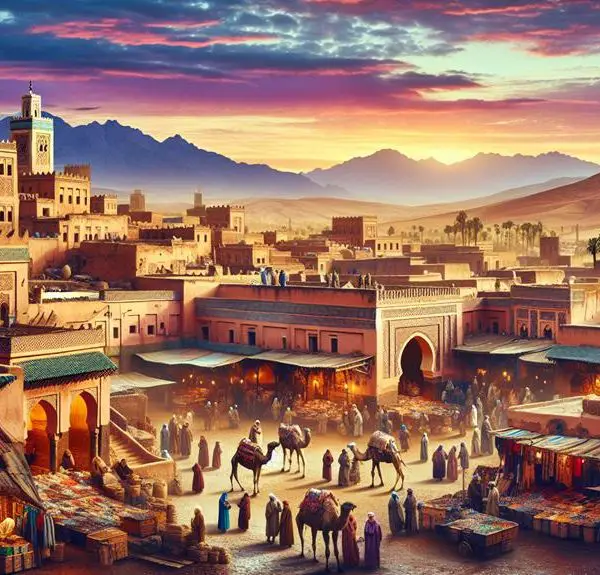
Sign up